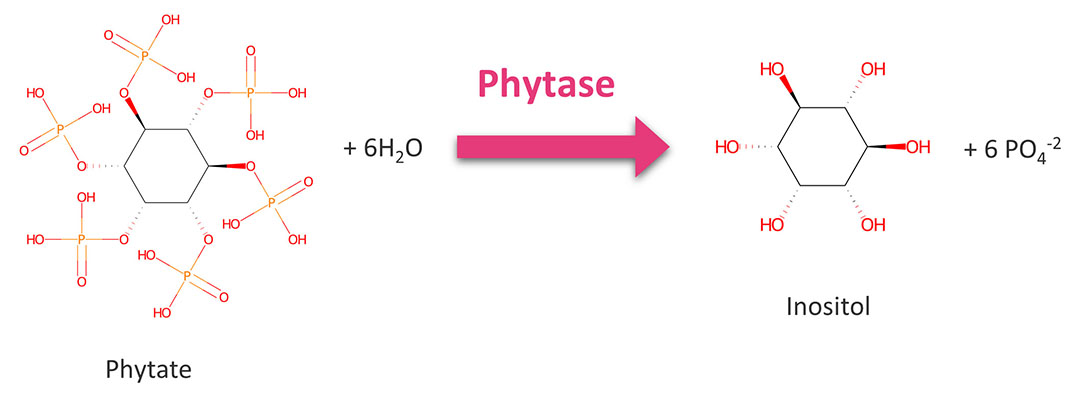Phytase and phytate
Phytic acid is a compound found in plants that stores phosphorus (P) in a highly stable form and also binds with various nutrients including minerals(Cu2+, Fe2+/3+, Ca2+, Mg2+, etc.), proteins, starches, and lipids. The aforesaid resulting salts are known as phytates. Phytases are phosphatases that can catalyze the hydrolysis of phytate and release phosphate.
Many plant-based ingredients commonly added in the diets of terrestrial and aquatic animal feeds are high in phytic acid. For nonruminant animals, phytic acid is largely indigestible and therefore can reduce nutrient utilization leading to reduced growth and bone mineralization as well as excessive phytic-P discharge to the environment.
The addition of phytases to feed does therefore enhance the availability of phosphate and minerals bound in phytates. Additionally, phytase might also be used in food for the improvement of the nutritional value of cereal food products by degrading phytate.
Importance of P
Phosphorus is one of the essential minerals for all living things, including poultry and pigs. Phosphorus being a part of energy currency, plays a critical role in cellular metabolism as well as it is also required in bone formation.
After energy and protein, phosphorus is the third most costly nutrient in feed. Some of this is consumed as plant phosphorus, of which around 60-80 percent is not digested by animals and some will be inorganic phosphorus from mineral sources such calcium phosphate, of which around 15-20 per cent will remain undigested.
Adding a phytase enzyme to the feed will unlock the phosphorus from phytic acid, permitting the animal to assimilate a higher level of the phosphorus in the feed. Lessening waste items containing phosphorus is additionally better for the earth. Phosphorus contained in animal waste in the end filters into groundwater, lakes, and streams. Algae flourish with phosphorus and multiply in its presence, which exhausts the quantity of oxygen in the water, destroying plants and compromising the local ecosystem.
Action mechanism of phytase
As stated above,Phytate is a complex molecule that exists in feed ingredients of plant origin. About 28% of phytate is phosphorus, but much of this phosphorus is of little value to the poultry and pig, because it secretes only small and inadequate amounts of the phytase. enzyme. Exogenous phytase when added in the feed releases the bound Phosphorus in stepwise manner and thus increases its availability to them.

Source of phytase
The microflora which inhabits the hindgut of the animals possesses phytase activity. However, the breakdown of phytate in the large intestine is of little value to them, because there is little absorption of phosphorus once the digesta leaves the small intestine;
Some ingredients, such as wheat, barley, triticale and rye also contain the enzyme; this phytase is believed to be particularly susceptible to heat, such that pelleting is assumed to virtually eliminate any benefit from plant-based phytase.
Exogenous phytase is derived principally from bacteria (e.coli) or fungi (Aspergillus niger, peniophora lycii). Phytase activity is typically reported in phytase units (FTU); in a laboratory setting, one FTU liberates 1 umol of inorganic phosphate per minute from 0.0051 mol/L of sodium phytate at pH 5.5 and at 370 °C.
Enzymes are sensitive to pH and each enzyme has an optimal pH point for its optimum performance. Phytase activity depends on pH with Ideal pH being somewhere in the ~2.5 – 5.5 range. phytases should maintain their activity at 80–90 °C for 3–5 min in the pelleting process.
Beneficial effects of phytase
(1) Allows the utilization/absorption of bound/stored nutrients in phytate – phytase can hydrolyze phytic acid, releasing phosphorus and other nutrients bound by phytic acid (E.g. minerals, protein and starch );
(2) Prevents phytic acid from binding to important minerals in the digestive tract – which would otherwise make them unavailable to the body.
(3) Lowering the feed cost. To compensate the deficiency of Phosphorus, additional phosphorus is added in the diet in the form of Dicalcium Phosphate that results in increase feed cost. Phytase addition somewhere reduces the feed cost by increasing the availability of Phosphorus and decreasing the requirement of addition of Phosphorus source in the feed.
(4) Diminishing the environmental pollution. Phosphorus being in bound form, passes in the excreta as such, thus being deposited in the natural resources. Extraction of phosphorus leads to depletion of non-renewable resources. Phytase addition solved this problem to some extent.
Key Reference
1. Phytase







